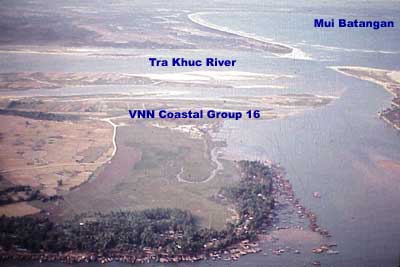
Photograph courtesy of Stew Harris
| VNN Coastal Group 16 |
| August 7-8, 1967 |
| Song Tra Khuc River |
 Photograph courtesy of Stew Harris |
"Before dawn on 7 August 1967 an enemy force of about two battalions launched a frontal assault on Coastal Group 16's base, about seventy miles southeast of Da Nang" .... "The U.S. advisors at the base, Lieutenant William C. Fitzgerald, Lieutenant (j.g.) Anthony C. Williams, Chief Engineman Harold H. Guinn, and Boatswain's Mate First Class Leo E. Pearman were swept into the fight as the situation became desperate. Lieutenant Fitzgerald radioed for help; PCF-20, patrolling nearby, intercepted the message, relayed it to other Market Time units, and headed for the base at flank speed. Arriving in less than twenty minutes, the Swift opened fire on enemy mortar and automatic weapons sites that had been set up on the river bank adjacent to the base Within minutes, the large enemy force was penetrating the northern minefield defenses of the base. Numerous Vietnamese Navy defenders were already dead, including the commander of the coastal group, Lieutenant (j.g.) Nguyen N. Thong, VNN. About three hundred enemy troops broke through and overran the central area of the base. The American advisors retreated to a bunker, where they continued firing on the advancing enemy. PCF-75 soon arrived, and five minutes later the VNN PCE-10 joined the fray. All three craft delivered heavy fire, but they and the base defenders were unable to stop the enemy. Soon the base was under enemy control, and it appeared to Lieutenant Fitzgerald that his bunker was the last point of resistance. Ordering his men to escape to the river, he remained behind to provide covering fire. He also radioed a nearby U.S. artillery unit and called a strike on his position. Once his men were clear, Lieutenant Fitzgerald tried to withdraw, but as he left the bunker a bullet struck him in the back of the head and killed him." "In the meantime, the USS Camp (DER-251), USS Gallup (PG-85), PCFs 15 and 54 and a U.S. Air Force 'Dragon Ship' had arrived and were saturating the enemy positions within the base with counter fire. The Swift Boats evacuated approximately forty Vietnamese to the Camp; fifteen of them were subsequently flown by helicopter to the Vietnamese hospital at Quang Ngai".."For the next several hours, the ships and aircraft kept up a steady barrage until one U.S. and two ARVN infantry companies arrived and launched a counterattack against the Viet Cong forces. Within a half hour the base was again in friendly hands." "All but one of the base's buildings had been destroyed in the battle. Fourteen Vietnamese Navy men had been killed; thirty five more were wounded. Twenty civilians were also killed. Thirty five VC suspects who were detained at the base had been freed, and three others were killed" |
|
|
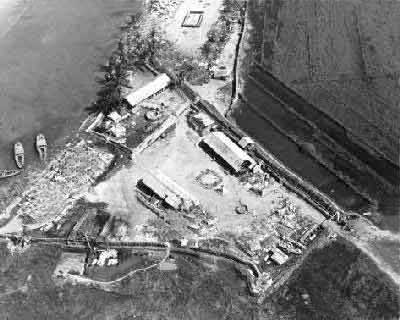 |
Old "Day Late and a Dollar Short" #45's after end was safely nested and moored among the other off-patrol PCF's at the pier back in Chu Lai when the above battle took place during the early morning of the 7th. But by that afternoon we were back on station with the assignment to patrol the river mouth adjacent to the Coastal Group compound during the night. |
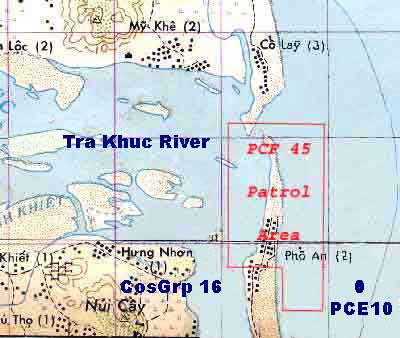 |
As could be imagined, tensions were running high in the aftermath of the this tragedy, with the expectations that the Viet Cong would try some follow-up actions. The Vietnamese Gunboat (PCE-10) remained anchored just off the mouth of the Song Tra Khuc river to provide support to the compound with her 40 mm cannon. So, as sunset approached, the first order of business was to go along side this allied vessel to co-ordinate the night's operations. Speaking with the VNN skipper and his US Naval advisor, the inshore and river areas where PCF 45 would be during darkness were carefully laid out. A plea was also made to restrain their nervous gunners from using our Swift Boat for target practice. But, the best laid plans ..... |
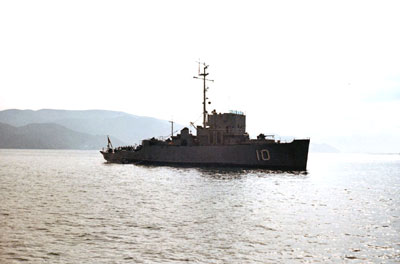 |
Sporadic gunfire was received during the night from the sand bar just to the east of the compound. However, the only significant result of these outbursts was this spectacular image ... as the gun tub 50's attempted to suppress this gunfire. |
 |
Of more lasting consequence to our psyche was PCE-10's reaction a short while later. We were taken under fire from the gunboat's 40 mm weapons. Fortunately, the dark coloring of the boat's paint scheme melded with the background of the shoreline and led to inaccurate aiming by the VNN gunners. Frantic radio calls by our onboard VNN liaison eventually brought a halt to this "friendly fire". But while it lasted, every member of the crew just "knew" that those large caliber tracers were going to end up in their belly buttons. Decades later, the memory of those terrifying moments, knowing that it was friendly forces on the other end, would make reading about the Alpha Troop, 4th Squadron, 7th Cavalry's similar, but more fateful, experience during the Gulf War action at 73 Easting a lot more vivid. On our way back to Chu Lai the following day, we did not even stop by PCE-10 to discuss the matter. The much larger tragedy at the Coastal Group compound made this incident seem trivial. |
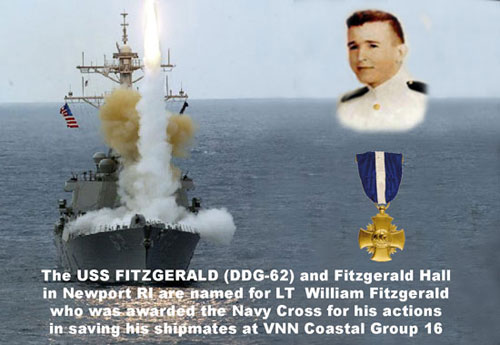 |
Stew Harris was assigned as the Senior Naval Advisor to Coastal Group 16 in April 1968 and completed his tour of duty there in April 1969. It is a tribute to the resilience and determination of both the Vietnamese and Americans that this base was not only rebuilt after its almost total destruction in August 1967, but that it continued to remain active in spite of the of the overwhelming North Vietnamese military precence in the area. The base remained in operation until the turnover of American bases and naval resources to the SVN Navy in 1970-71 made available other, better equipped places to operate from. As can be seen in the following images, the base was restored to its former status with Yabuta craft conducting agressive patrols of the Tra Khuc and Mui Batangan areas. Stew was even able to put in a jab at the Americal units operating in the area by painting "Go Navy" on the top of his living hooch and inviting some Mehonite missionaries out for a "spot of tea". Anything to relieve the tension of a having a brigade of NVA looking over your shoulder. Stew says that the sign brought results in the form of Army brass dropping by bearing gifts of packaged steaks!! But the war was never very far off. The Marine A4 strike on the sand bar where PCF-45 took fire a year before, and the VNAF close air support against the not-so-nice-guys on the hill overlooking the base, just reminded Stew how lucky he was to be going home in one piece after his tour. For more vivid descriptions of life at Coastal Group 16, visit Stew's collection of Tales From the Tra Khuc River
|
|
|
This web site is Copyright � 2002 by Robert B. Shirley. All rights reserved. Click on image to return to the homepage
|